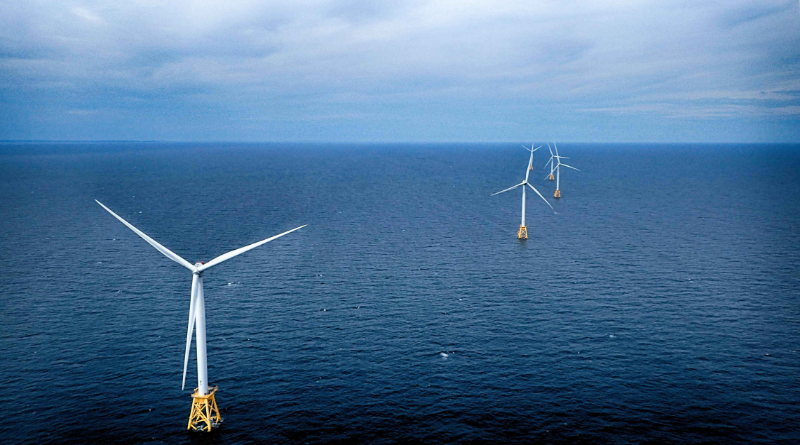Life Is Lovely Now That Block Islanders Have Offshore Wind Power
Support CleanTechnica's work through a Substack subscription or on Stripe.

If you’ve never visited Block Island, you definitely need to put it on your bucket list. Located sixteen miles across Block Island Sound from the mainland’s nearest point at Point Judith, Rhode Island, the vacation destination has many appealing features. Envision long white sand beaches, Victorian inns that are a throwback to a gentile era, numerous natural features like kettle ponds and wooded walking paths, and bikeways that meander over knolls and across the inclines of granite cliffs. Almost 50% of the island is protected space — Block Islanders prize its natural beauty.
On the island’s southeastern coast, the Mohegan Bluffs rise over 60 meters above the sea. The view from here is unique: five wind turbines are located approximately 5 km from shore. The turbines are placed strategically to rest within state waters, which extend only 5.6 km from shore.
Offshore wind is a relatively new development in the global energy profile. The US eastern seaboard is an ideal location for utility scale offshore wind. The area has the perfect storm of high energy prices, dense populations with large energy demands, high wind speeds, shallow waters, and state policy support for renewables.
With all the controversies posed and lies slung by President Donald J. Trump about offshore wind (“It is the worst form of energy, the most expensive form of energy, but windmills should not be allowed”), you might think that Block Islanders would be torn with high emotion about the wind turbines off their shoreline today.
But you would be wrong. Block Islanders love how offshore wind has improved their lives. Now the island is connected to the Block Island Offshore Wind Project (BIOWP) and the mainland power grid. “The benefits have been extraordinary,” Keith Stover, head of the island’s Town Council, told the New York Times.
Why Block Islanders Became Offshore Wind Proponents
The year-round Block Island population of 1000 permanent residents balloons to 20,000 or more residents during the summer tourism season. Whether seasonal or permanent, the locals are experiencing a better quality of life due to the BIOWP.
Say goodbye to generators: Prior to the wind turbines, Block Islanders relied exclusively on five local diesel generators, which posed many problems. Loud — really loud — dirty, wasteful, inefficient: the generators were powered by millions of gallons of diesel shipped over by ferry and stored underground.
Inconsistent electricity: Before the BIOWP, there were the power surges and brownouts that would damage household appliances. The inconsistent electricity is known to cause damage to sensitive electronic circuits inside appliances, especially those with digital displays. It can lead to a total breakdown or intermittent problems that are hard to diagnose.
Cost of electricity: Energy costs, tied to the volatile oil market, fluctuated all the time pre-offshore wind, and island businesses struggled to manage their budgets. The cost of electricity now is less than a third of what it would be if the island were still running on diesel. The diesel generators are idle and silent, reserved for emergencies.
Internet reliability: Block Island is now connected to the mainland grid by a $120 million undersea cable, which also brings reliable broadband internet — a first for the island. Before, the island school barely had the bandwidth to participate in state testing. Current improved electricity and internet are critical to attracting visitors.
Celebrating the natural world: Many Block Islanders strongly support a proposal to expand the BIOWP as a necessary path to tackle climate change. Residents support offshore wind as part of a larger worldview in which island conservation is essential — more than 40% of land is protected from development. After the offshore turbines went up and running, new sounds emerged in daily island life: quiet, birdsong, wind in trees, waves pounding on the shore.
Marine habitat created: Recreational anglers say the fishing is quite productive around the turbines, as the underwater structures are creating artificial reefs. As offshore wind power development ramps up in the US, scientists and advocates are exploring how a well-known biological principle—that complex habitat promotes diversity of wildlife—can apply in this new context.
Surplus energy: The BIOWP creates energy in excess of the island’s demands, so the extra amount is sent as surplus into the grid. Nonetheless, partially because wind power has intermittency and at this time costs more than fossil fuels, the islanders buy a mix of energy through the grid. It’s a standard practice to cover all eventualities.
Electricity cooperative: The BIOWP is just the first foray into renewable energy independence for these islanders, who are now striving to to create Rhode Island’s first electricity cooperative. Creating a co-op required new state legislation, and a town task force had been formed to accomplish the goal.
Community Perceptions about Living with Offshore Wind
By day, the BIOWP turbines look like tiny white toothpicks on the horizon, but at night, when they blink red, their visual footprint is more prominent.
After a year living beside operating turbines, a greater percentage of Block Islanders thought the turbines fit well with the landscape during daylight (64%) than did the percentage of RI coastal residents (46%). Mean support was high and consistent across the entire population.
Researchers concluded at the time that the closer a community is to a project, the more easily or quickly it may crystallize its attitude. Moreover, they surmised that communities may become ambiguous to aesthetics over time, as offshore wind power becomes commonplace.
Such matter-of-fact approaches to changes inherent with renewable energy adoption don’t seem to be in the mindset of Trump and his coterie. And it’s not just a recent phenomenon. Remember that fateful year of 2016, when he was first elected US President? It’s the same year that the turbines started delivering electricity to Block Islanders.
Again, in just the few short months that have gone by since he retook the Oval Office, Trump has attempted to smother almost the entire US offshore wind industry by revoking access to federally authorized offshore wind sites. The Administration has cancelled $679 million in funding for offshore wind projects.
Citing “concerns that have arisen” during a review, the US Department of the Interior (DOI) informed the LLC that it could not resume any activities until notified. The announcement threatened already tenuous wind alliances across commercial fishers, the offshore wind industry, environmentalists, clean power advocates, and investors.
Just this week the Danish offshore wind developer Ørsted heard good news about its lawsuit to resume work on its 704-megawatt Revolution Wind. Let the wind blow!
 Sign up for CleanTechnica's Weekly Substack for Zach and Scott's in-depth analyses and high level summaries, sign up for our daily newsletter, and follow us on Google News!
Sign up for CleanTechnica's Weekly Substack for Zach and Scott's in-depth analyses and high level summaries, sign up for our daily newsletter, and follow us on Google News!
Have a tip for CleanTechnica? Want to advertise? Want to suggest a guest for our CleanTech Talk podcast? Contact us here.
Sign up for our daily newsletter for 15 new cleantech stories a day. Or sign up for our weekly one on top stories of the week if daily is too frequent.
CleanTechnica uses affiliate links. See our policy here.
CleanTechnica's Comment Policy

